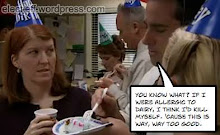1) Bring a handout for everyone! (the final write up that you turn in on CD is not your presentation)
2) Don't put too many words on a powerpoint slide because it's impossible/very difficult to process and/or stay focused
3) Only use interview video snippets if
- they're going to say something you really need to say
- they're easy to understand
- they're really concise and to the point
- you provide subtitles
4) Tell us at the beginning what you did for your diagnostic. Without this we have no schema for understanding/appreciating the rest of your presentation. What were you looking for, who did you include in your study, etc.
5) When you do your individual lines about what you liked best etc., BE CONCRETE. That would be the whole point of the class! If you just say something like, They value family more than we do, I will become violent. That doesn't tell us anything! What concrete behaviors are you talking about or concrete contexts for behaviors with concrete interactional functions that you can prove are not the norm in the U.S. ???? Touching the mother in law's feet is an excellent example of a concrete statement.
6) It would be better for you to have a video snippit of each member saying their sentences aloud than to have them printed out word for word on the screen. You could have it in subtitles though, accompanying the video snippit, which would probably enhance clarity.
7) When you finish, tell us what you think your diagnostic demonstrated--what did you conclude? You don't need extensive statistics, but it would be very helpful if you would point out something like 25 out of 30 Americans thought the people in the scene were being appropriately respectful to the appropriate other participants. Don't go crazy but a chart or something would be very helpful here.
And I remind you: Each beautiful sentence should be a work of art (and heart, hopefully).








No comments:
Post a Comment